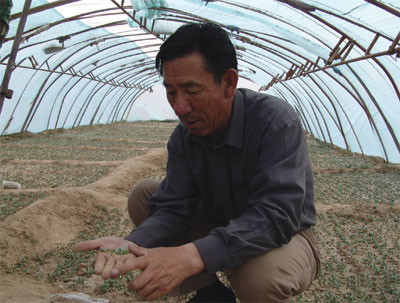The sand combatant
 |
|
Wang Youde. |
It is cold in early spring in northwest China. But one man is often braving the chill in strong sandstorms to plant trees on the rolling hills of Baijitan National Nature Reserve in Ningxia Hui Autonomous Region.
This is Wang Youde, director of the nature reserve, who is famous for planting 30,000 mu (about 2,010 hectares) of trees every year to curb the invasion of Mu Us Desert.
"Early spring is the best season to plant trees. We have no time to lose," Wang said. He is responsible for eight afforestation projects and 13 regular sand curbing projects.
His fight against sand began more than 20 years ago.
Wang was born in 1954 into a Hui family in Ningxia. His hometown used to have plenty of water and lush grass, but overgrazing has caused the grass to disappear and sandstorms to grow stronger year by year.
In one decade, more than 20 villages, with a total population of 30,000, were forced to leave their home. Another 200 kinds of animals disappeared.
"I made up my mind at that time to take back the land seized by desert," Wang said.
In 1985, he was appointed the vice director of a forest farm in Baijitan. The farm was a terrible mess. Workers had nothing to do for seven months of the year. Their annual income totaled only a few hundred yuan. Most of them wanted to quit.
Wang refocused the farm on reclaiming desert land. His reform has made noticeable success. In the first year, the farm planted 5,093 mu (about 341 hectares) of trees and produced profits of about 90,000 yuan (US$13,891). The once empty farm leapt back to life.
From then on, Wang began to try everything he can to tackle the desert.
"He is almost 60 years old now, but he still works 14 hours a day," said one of his colleagues. "When he is out, he always carries a pair of scissors, a saw, a ruler and a flashlight so that he can trim plants at any time and handle saplings at night."
In the past, Baijitan was covered by boundless desert. Now it has been turned into a national nature reserve with a variety of plants and beautiful sceneries.
Amid the efforts to combat sand, Wang and his colleagues have suffered many setbacks. Time and again, the land where they planted trees were recovered by sand. Despite all these difficulties, over the past years, Wang and his colleagues have planted 480,000 mu (3,216 hectares) of trees, keeping almost 1 million mu (67,000 hectares) of desert under control.
"There are two kinds of work that one can't neglect: The work you must do and the work you like," Wang said. "Fortunately, combating sand is what I like and must do."
 0
0 







Go to Forum >>0 Comments